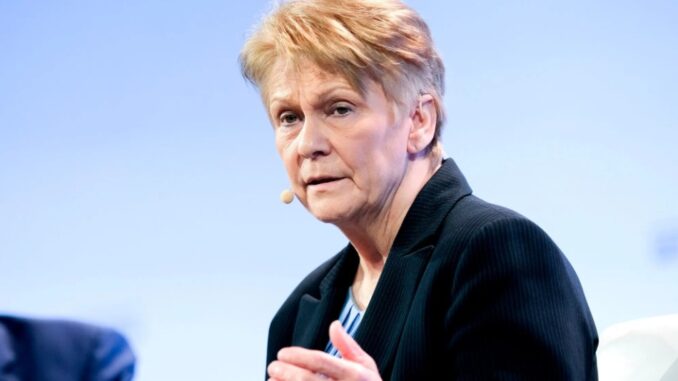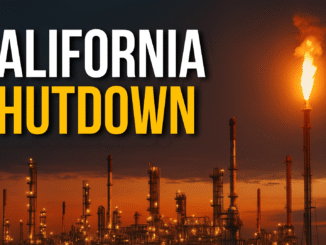
In a market still reeling from geopolitical tensions and shifting global demand patterns, Occidental Petroleum CEO Vicki Hollub delivered a sobering yet strategic outlook at the Energy Intelligence Forum in London this week. Hollub projected that crude oil prices will remain confined to a narrow band of $58 to $62 per barrel through 2026, describing the range as “tight” amid persistent supply constraints and balanced-but-fragile demand. This forecast, while modest on the upside, underscores a stabilizing force for U.S. producers navigating volatility—yet it also highlights vulnerabilities as natural gas dynamics increasingly intersect with oil markets.
For Occidental, a Permian Basin heavyweight with integrated operations spanning upstream production to carbon capture, Hollub’s comments signal disciplined capital allocation. The company, which has leaned into efficiency gains and debt reduction post its 2023 CrownRock acquisition, could thrive in this predictable pricing environment. Broader implications ripple across U.S. shale operators: At $60 oil, breakeven costs in key basins like the Permian (hovering around $45-50 per barrel) remain comfortably covered, encouraging steady drilling without the boom-bust cycles of yesteryear. However, the tight range leaves little margin for error if non-OPEC supply surges or economic slowdowns bite.
Got Questions on investing in oil and gas? Or do you have a Tax Burden in 2025?
As oil steadies, natural gas emerges as the wildcard. U.S. production and consumption are on track to shatter records in 2025, driven by surging LNG exports and an AI-fueled power boom, potentially amplifying pressures on integrated producers while reshaping investor and consumer landscapes.
A Constrained Oil Horizon: Hollub’s Call and Market Realities
Hollub’s $58-$62 forecast through 2026 aligns with broader analyst consensus but tempers optimism around post-2025 upside. Speaking at the forum, she emphasized market tightness born of OPEC+ discipline and non-OPEC production plateaus, with prices expected to climb meaningfully only after 2026 as demand from emerging economies accelerates. This view echoes the U.S. Energy Information Administration’s (EIA) Short-Term Energy Outlook, which anticipates West Texas Intermediate (WTI) crude averaging $62 per barrel in 2025 before dipping slightly in 2026 amid moderated global growth.
For U.S. oil producers, this range is a double-edged sword. On one hand, it supports Permian output growth—expected to rise 9% in 2025 to 28 Bcf/d of associated gas, per EIA data—bolstering cash flows for firms like Occidental, EOG Resources, and Pioneer Natural Resources. On the other, it caps explosive returns, prompting a focus on free cash flow over aggressive expansion. “We’re in a world where capital discipline is king,” Hollub noted, reflecting a sectorwide pivot toward shareholder returns via dividends and buybacks.
Yet, oil’s stability could be tested by natural gas crossovers. In the Permian, where 20% of U.S. gross gas production originates, flaring restrictions and pipeline bottlenecks are forcing operators to curtail oil drilling if gas takeaway capacity lags. Recent infrastructure delays, including stalled Permian pipeline expansions, exacerbate this, potentially shaving 1-2% off regional oil growth if unresolved.
Natural Gas Demand Surge: Record Highs and Ripple Effects
While oil prices hug the middle ground, natural gas is anything but subdued. The EIA forecasts U.S. dry gas production climbing to a record 107.1 Bcf/d in 2025 and 107.4 Bcf/d in 2026, outpacing 2024’s 103.2 Bcf/d. Demand tells an even hotter story: Domestic consumption hits 91.6 Bcf/d in both years, up from 90.5 Bcf/d last year, fueled by LNG exports (adding over 5 Bcf/d capacity in 2025-2026) and power sector needs.
The culprits? AI data centers and electrification. Data centers alone could devour 9% of U.S. electricity by 2030, translating to over 3 Bcf/d in new gas demand by decade’s end, with hyperscalers like Amazon and Google ramping gas-fired generation to meet immediate needs.
LNG exports, meanwhile, hit records in August 2025 amid Europe’s pivot from Russian supplies, with feedgas deliveries setting quarterly highs in Q1.
Extreme weather amplified this: January 2025’s coldest month in decades spiked residential and power use by 21.9% year-over-year.
Prices are responding. Henry Hub spot prices, averaging $3.60/MMBtu in 2025, are projected to reach $4.30/MMBtu in 2026—a 43% jump from late 2024 lows—as demand outstrips supply growth by 3.2 Bcf/d annually.
This steepens the forward curve, with analysts like East Daley forecasting even higher averages if LNG ramps faster than expected.
Impacts on U.S. Oil and Gas Producers: Synergies and Strains
For integrated producers like Occidental, the gas boom is a boon. Associated gas from Permian oil wells—accounting for much of the basin’s 2.3 Bcf/d growth in 2025—turns marginal barrels into profit centers, with upside from LNG-linked contracts hedging volatility.
Smaller pure-play gas firms, such as EQT, eye output hikes of 2% in Appalachia to 37.6 Bcf/d in 2026, capitalizing on Northeast data center demand via new pipelines like Mountain Valley.
Challenges loom, however. Infrastructure lags could trap 1-2 Bcf/d in the Permian, forcing curtailments that dent oil production and inflate local basis differentials—potentially by $1-2/MMBtu.
Rising gas prices may also erode coal’s edge in power generation, indirectly supporting gas but pressuring oil-linked economics if cross-subsidies shift.
Overall, producers face a “ride out the storm” scenario: 2024’s low prices tested resilience, but 2025’s demand flip could reward survivors with 20-30% margin expansion.
Investor and Consumer Crossroads:
Opportunities Amid Tradeoffs
Investors stand to gain from this bifurcation. Oil’s tight range offers defensive plays—Occidental’s 1.5% dividend yield and $3 billion buyback authorization appeal to value hunters—while gas exposure via ETFs like UNG or stocks like Cheniere Energy promises 15-20% returns if prices hit $4.50/MMBtu.
M&A activity, already at $150 billion in 2024, could surge in gas-rich basins, consolidating supply chains for LNG and data centers. Yet, volatility risks persist: A mild winter or delayed LNG projects could cap upside, echoing 2024’s glut.
Consumers face steeper bills. Higher gas prices—up 19% in futures since February—translate to $50-100 annual hikes per household via electricity and heating, per American Gas Association estimates.
Industrials, consuming 32% of U.S. gas, may electrify processes or pass costs downstream, inflating goods prices by 1-2%.
On the flip side, reliable gas supply underpins AI-driven growth and energy security, averting blackouts that could cost billions.
Navigating the Tightrope: A Balanced Energy Future
Hollub’s oil forecast paints a picture of controlled equilibrium, but the natural gas renaissance adds dynamism—and urgency. U.S. producers must invest in pipelines and tech to harness demand without bottlenecks, while investors weigh oil’s steadiness against gas’s growth potential. For consumers, the bill may rise, but so does the promise of a resilient grid powering tomorrow’s innovations.As 2025 unfolds, watch LNG ramps and data center builds: They could validate Hollub’s post-2026 oil rebound while supercharging gas economics. In energy’s marathon, discipline today yields dividends tomorrow—for producers, portfolios, and the powering of progress.
Got Questions on investing in oil and gas? Or do you have a Tax Burden in 2025?
Crude Oil, LNG, Jet Fuel price quote
ENB Top News
ENB
Energy Dashboard
ENB Podcast
ENB Substack







